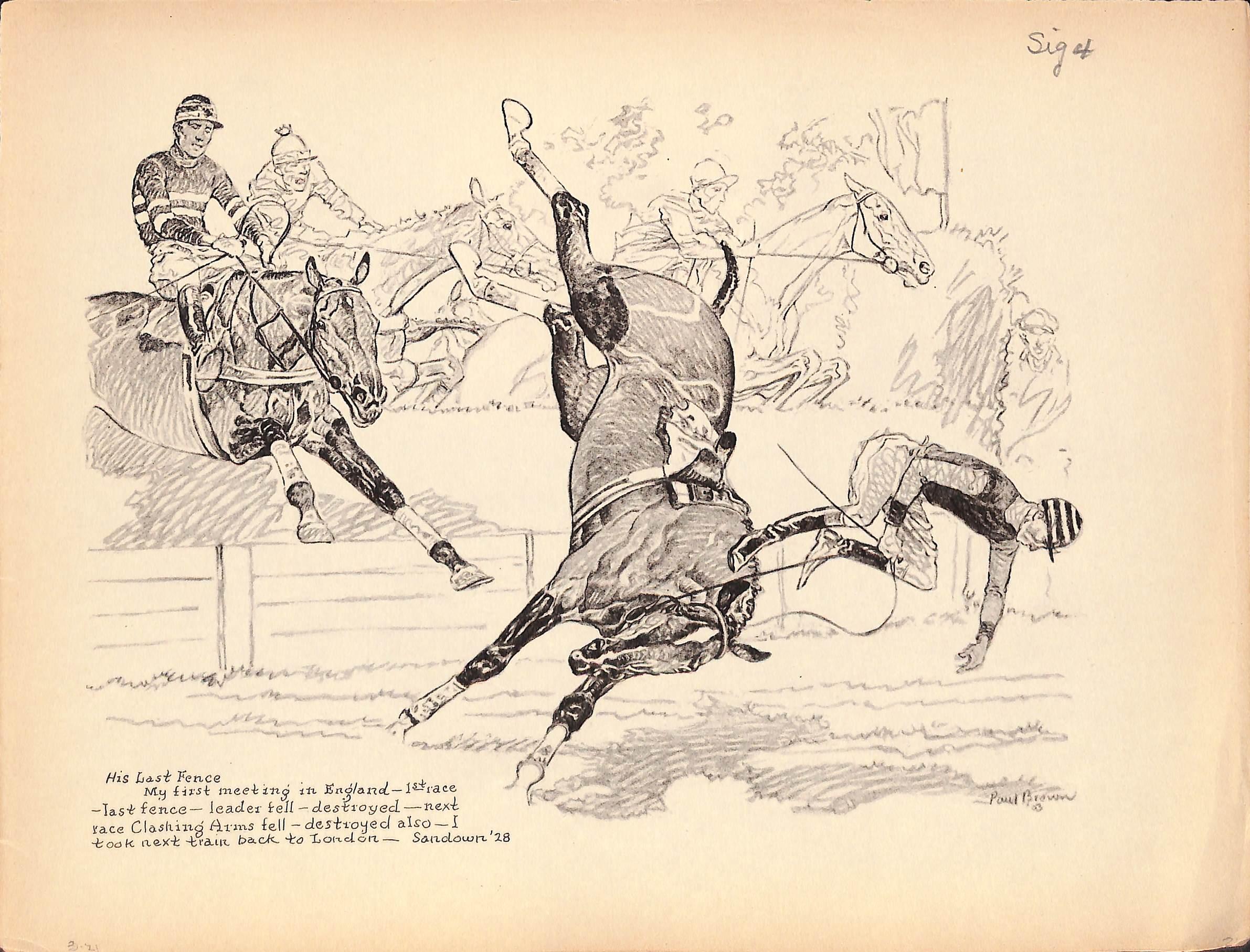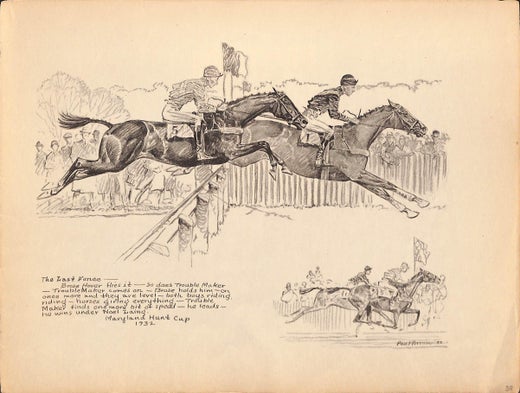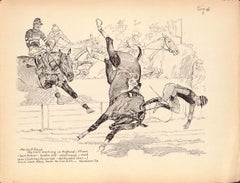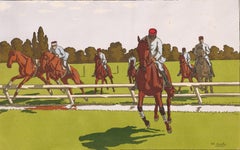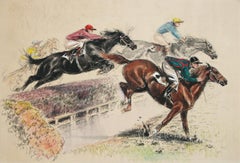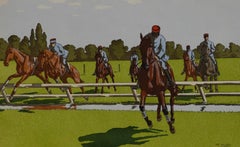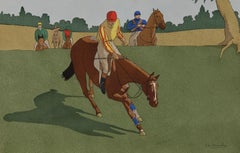Items Similar to The Tumblers - A Big Springy Fence North Warwickshire Point To Points 1929
Want more images or videos?
Request additional images or videos from the seller
1 of 2
Paul Desmond BrownThe Tumblers - A Big Springy Fence North Warwickshire Point To Points 1929
$500
£377.90
€435.55
CA$705.50
A$777.51
CHF 407.05
MX$9,550.28
NOK 5,114.70
SEK 4,786.95
DKK 3,251.98
About the Item
Art Sz: 9 1/2"H x 12 1/2"W
1933
Proof Plate for 'Spills and Thrills' Published by Charles Scribner's Sons New York 1933
- Creator:Paul Desmond Brown (1893 - 1958, American)
- Dimensions:Height: 9.5 in (24.13 cm)Width: 12.5 in (31.75 cm)
- Medium:
- Period:
- Condition:
- Gallery Location:Bristol, CT
- Reference Number:Seller: 347011stDibs: LU1260113552092
Paul Brown was an American illustrator of equestrian subjects although he was never formally trained as an artist. He is primarily known for his paintings, drawings and sketches of horses and equestrian sports. He is also well-known for his over three decades of illustrations for Brooks Brothers catalogs including more than one-thousand drawings. These illustrations made him a major influence on the image of urban males in twentieth-century America. With Paul Brown's art, color is only an occasional adjunct playing a very secondary role to the use of the hard-edged line. His style has a calculated simplicity, a casual appearance, but is very carefully contrived and executed with much authority. Illustrations by Paul Brown drew heavily upon copious notes and studies, often aided by photography as well as photographic memory. Brown preferred to draw with a pencil and, although not fond of painting, successfully employed a technique of using tinted paper with white highlights. During the heyday of polo in the 1930's, Paul Brown immortalized the sport for many in his illustrations for Peter Vischer's POLO magazine, of which Brown was a member of the editorial board. "Today those historical moments are often taken for granted, as is much of the past, but we still have Paul Brown's unique legacy to breathe life into those special times." Illustrating and writing books became Brown's main occupation, and he worked with the major publishers of the day including The Derrydale Press, Charles Scribner's Sons, Dodd, Mead & Company.
About the Seller
4.8
Vetted Professional Seller
Every seller passes strict standards for authenticity and reliability
Established in 2000
1stDibs seller since 2019
131 sales on 1stDibs
Typical response time: <1 hour
- ShippingRetrieving quote...Shipping from: Bristol, CT
- Return Policy
Authenticity Guarantee
In the unlikely event there’s an issue with an item’s authenticity, contact us within 1 year for a full refund. DetailsMoney-Back Guarantee
If your item is not as described, is damaged in transit, or does not arrive, contact us within 7 days for a full refund. Details24-Hour Cancellation
You have a 24-hour grace period in which to reconsider your purchase, with no questions asked.Vetted Professional Sellers
Our world-class sellers must adhere to strict standards for service and quality, maintaining the integrity of our listings.Price-Match Guarantee
If you find that a seller listed the same item for a lower price elsewhere, we’ll match it.Trusted Global Delivery
Our best-in-class carrier network provides specialized shipping options worldwide, including custom delivery.More From This Seller
View AllHis Last Fence Sandown 1928
Located in Bristol, CT
Art Sz: 9 1/2"H x 12 1/2"W
1933
Proof Plate for 'Spills and Thrills' Published by Charles Scribner's Sons New York 1933
Category
1930s Drawings and Watercolor Paintings
Materials
Paper, Lithograph
Pickering 1932 - The Last Fence
Located in Bristol, CT
Art Sz: 9 1/2"H x 12 1/2"W
1933
Proof Plate for 'Spills and Thrills' Published by Charles Scribner's Sons New York 1933
Category
1930s Drawings and Watercolor Paintings
Materials
Paper, Lithograph
Gypsy King Dove Through 3rd Ditch And Fence Llangollen Cup 1932
Located in Bristol, CT
Art Sz: 9 1/2"H x 12 1/2"W
1933
Proof Plate for 'Spills and Thrills' Published by Charles Scribner's Sons New York 1933
Category
1930s Drawings and Watercolor Paintings
Materials
Paper, Lithograph
Dramatic - I'll Say So - Next Last Fence Grasslands 1930
Located in Bristol, CT
Art Sz: 9 1/2"H x 12 1/2"W
1933
Proof Plate for 'Spills and Thrills' Published by Charles Scribner's Sons New York 1933
Category
1930s Drawings and Watercolor Paintings
Materials
Paper, Lithograph
Cuckoo Hit First Fence Adjacent Hunts Ladies Race 1929
Located in Bristol, CT
Art Sz: 9 1/2"H x 12 1/2"W
1933
Proof Plate for 'Spills and Thrills' Published by Charles Scribner's Sons New York 1933
Category
1930s Drawings and Watercolor Paintings
Materials
Paper, Lithograph
The Last Fence Maryland Hunt Cup 1932
Located in Bristol, CT
Art Sz: 9 1/2"H x 12 1/2"W
1933
Proof Plate for 'Spills and Thrills' Published by Charles Scribner's Sons New York 1933
Category
1930s Drawings and Watercolor Paintings
Materials
Paper, Lithograph
You May Also Like
Equestrian Scene No. 10: Horse Jumping
By Charles Ancelin
Located in New York, NY
Equestrian Scene No. 10 by Charles Ancelin. Original hand-painted pochoir process print. Paris: Galerie Lutetia, circa 1920.
Category
1920s Animal Prints
Materials
Paper
Saut de la Ravine original watercolor by Louis Claude 1928
By Louis Claude
Located in Paonia, CO
Saut de la Ravine original watercolor by Louis Claude 1928 is a very rare watercolor by Louis Claude created for the publishing house of Sidney Lucas. Mr. Lucas lived in France f...
Category
1920s Other Art Style Animal Paintings
Materials
Watercolor
$2,275 Sale Price
35% Off
Charles Ancelin (1863-1940) - c.1925 Pochoir Print, Chevaux De Courses (No.6)
By Charles Ancelin
Located in Corsham, GB
An exciting study of a horse race with riders jumping over a post. This fine hand-coloured Pochoir print is signed in plate and inscribed in graphite with the print number in the ser...
Category
Early 20th Century Figurative Prints
Materials
Screen
Charles Ancelin (1863-1940) - c.1925 Pochoir Print, Chevaux De Courses (No.3)
By Charles Ancelin
Located in Corsham, GB
An exciting hand-coloured Pochoir print of race horses completing a cross-country race. The jocky's wear brightly coloured riding jumpers and look eminently stylish. Signed in plate....
Category
Early 20th Century Figurative Prints
Materials
Screen
Circus Lot at Toledo, Ohio, Early 20th Century Cleveland School Artist
By Frank Wilcox
Located in Beachwood, OH
Frank Nelson Wilcox (American, 1887-1964)
Circus Lot at Toledo, c. 1920
Watercolor on Whatman board
Signed lower right
22 x 30 inches
Frank Nelson Wilcox (October 3, 1887 – April 17, 1964) was a modernist American artist and a master of watercolor. Wilcox is described as the "Dean of Cleveland School painters," though some sources give this appellation to Henry Keller or Frederick Gottwald. Wilcox was born on October 3, 1887 to Frank Nelson Wilcox, Sr. and Jessie Fremont Snow Wilcox at 61 Linwood Street in Cleveland, Ohio. His father, a prominent lawyer, died at home in 1904 shortly before Wilcox' 17th birthday. His brother, lawyer and publisher Owen N. Wilcox, was president of the Gates Legal Publishing Company or The Gates Press. His sister Ruth Wilcox was a respected librarian.
In 1906 Wilcox enrolled from the Cleveland School of Art under the tutelage of Henry Keller, Louis Rorimer, and Frederick Gottwald. He also attended Keller's Berlin Heights summer school from 1909. After graduating in 1910, Wilcox traveled and studied in Europe, sometimes dropping by Académie Colarossi in the evening to sketch the model or the other students at their easels, where he was influenced by French impressionism. Wilcox was influenced by Keller's innovative watercolor techniques, and from 1910 to 1916 they experimented together with impressionism and post-impressionism. Wilcox soon developed his own signature style in the American Scene or Regionalist tradition of the early 20th century. He joined the Cleveland School of Art faculty in 1913. Among his students were Lawrence Edwin Blazey, Carl Gaertner, Paul Travis, and Charles E. Burchfield. Around this time Wilcox became associated with Cowan Pottery.
In 1916 Wilcox married fellow artist Florence Bard, and they spent most of their honeymoon painting in Berlin Heights with Keller. They had one daughter, Mary. In 1918 he joined the Cleveland Society of Artists, a conservative counter to the Bohemian Kokoon Arts Club, and would later serve as its president. He also began teaching night school at the John Huntington Polytechnic Institute at this time, and taught briefly at Baldwin-Wallace College.
Wilcox wrote and illustrated Ohio Indian Trails in 1933, which was favorably reviewed by the New York Times in 1934. This book was edited and reprinted in 1970 by William A. McGill. McGill also edited and reprinted Wilcox' Canals of the Old Northwest in 1969. Wilcox also wrote, illustrated, and published Weather Wisdom in 1949, a limited edition (50 copies) of twenty-four serigraphs (silk screen prints) accompanied by commentary "based upon familiar weather observations commonly made by people living in the country."
Wilcox displayed over 250 works at Cleveland's annual May Show. He received numerous awards, including the Penton Medal for as The Omnibus, Paris (1920), Fish Tug on Lake Erie (1921), Blacksmith Shop (1922), and The Gravel Pit (1922). Other paintings include The Trailing Fog (1929), Under the Big Top (1930), and Ohio Landscape...
Category
1920s American Modern Figurative Drawings and Watercolors
Materials
Watercolor
'Foul Rope (Left)' — Early American Southwest Rodeo
By William Robinson Leigh
Located in Myrtle Beach, SC
William Robinson Leigh, 'Foul Rope (Left)', etching, c. 1920, edition unknown but small. Signed in pencil and signed in the plate, lower left. A superb, richly-inked impression, in dark brown ink, on buff wove Umbria paper, the full sheet with margins (1 1/2 to 2 3/4 inches); slight toning at the sheet edges, otherwise in excellent condition. Very scarce. Archivally matted to museum standards, unframed.
Image size 14 7/8 x 11 15/16 inches (378 x 303 mm); sheet size 20 3/8 x 15 3/8 inches (518 x 391 mm).
ABOUT THE ARTIST
Born near Falling Waters, West Virginia, on a plantation a year after the Civil War and raised in Baltimore, William Robinson Leigh (1866 - 1955) became one of the foremost painters of the American West. His career spanning some seventy-five years, Leigh created some of the most iconic depictions of the Western landscape, with admirers referring to him as ‘The Sagebrush Rembrandt.’
The son of impoverished Southern aristocrats, Leigh received his first art training at age 14 from Hugh Newell at the Maryland Institute, where he was regarded as the best student in his class. From 1883 to 1895, he studied in Europe, mainly at the Royal Academy in Munich with Ludwig Loefftz. From 1891 to 1896, he painted six cycloramas or murals in the round, a giant German panorama.
In 1896, Leigh began working as a magazine illustrator for Scribner's and Collier's Weekly Magazine in New York City. He also painted portraits, landscapes, and genre scenes.
Leigh's trips to the Southwest began in 1906 when he agreed to paint the Grand Canyon with William Simpson, Santa Fe Railway advertising manager, in exchange for free transportation West. In 1907, he completed his Grand Canyon painting, which led to more commissions and an extensive painting trip through Arizona and New Mexico. These travels inspired him to paint western subjects for the next 50 years, and his primary interests were the Hopi and Navajo Indians.
In 1910, he traveled to Wyoming, where he painted in Yellowstone Park and created sketches, many of which he later converted into large canvases such as ‘Lower Falls of the Yellowstone’ (1915) and ‘Grand Canyon of the Yellowstone’ (1911).
In 1926, he traveled to Africa at the invitation of Carl Akeley for the American Museum of Natural History, and from this experience, wrote and illustrated 'Frontiers of Enchantment: An Artist's Adventures in Africa'. In 1933, he wrote and illustrated 'The Western Pony'. His adventures were chronicled in several popular magazines, including Life, the Saturday Evening Post, and Colliers.
For many years, Grand Central Art Galleries at the Biltmore Hotel handled his work exclusively in New York. In 1953, Leigh was elected an associate member of the National Academy of Design and became a full Academician in 1955.
In March 1999, the Historical Center of Cody, Wyoming, held an exhibition of his field sketches and finished works depicting his experiences near Cody early in the century. Between 1910 and 1921, when he often painted in the Carter Mountain vicinity, these years were considered pivotal to his artistic development and devotion to the Western landscape.
Leigh's work is held in many museum collections of American Western art...
Category
1920s Realist Animal Prints
Materials
Etching
More Ways To Browse
Architecture Drawing
Figurative Pen And Ink Drawings
French Watercolor 19th Century
Nude Woman Drawing
Horse Watercolour
Horses Watercolors
Nude Sketch
Lovers Drawing
French Charcoal Painting
Vintage Ink Pen
China Watercolor
Chinese Watercolour
Antique Watercolor Portrait
Floral Watercolor Paintings
Mid Century Drawings Figure
Female Nude Watercolor Paintings
Black And White Pencil Drawing
Pair Of Watercolors
